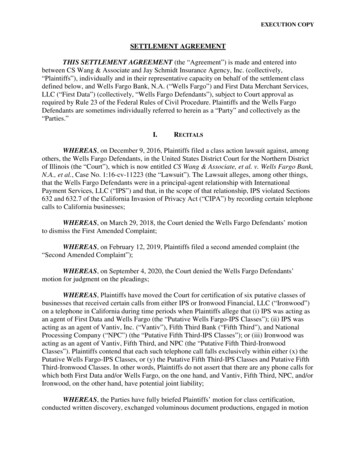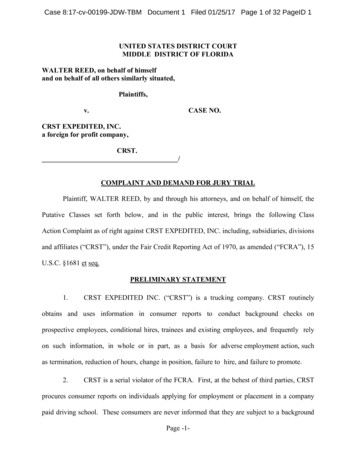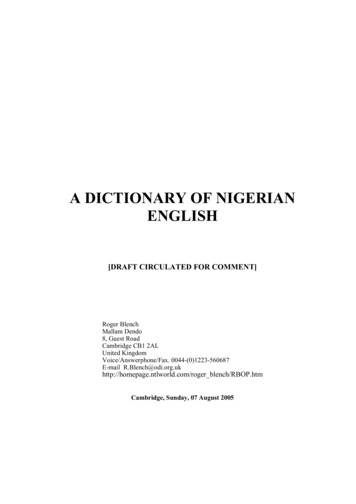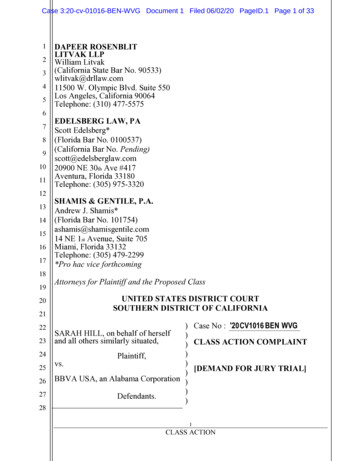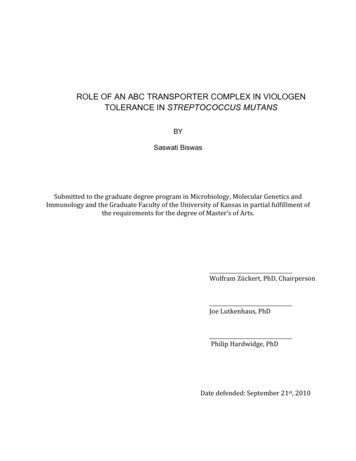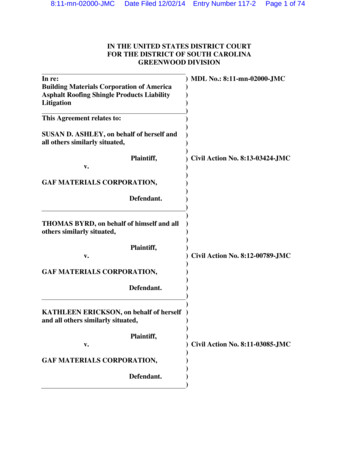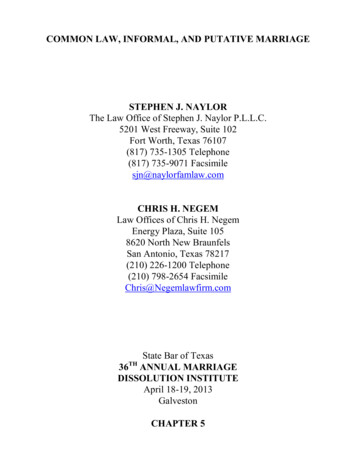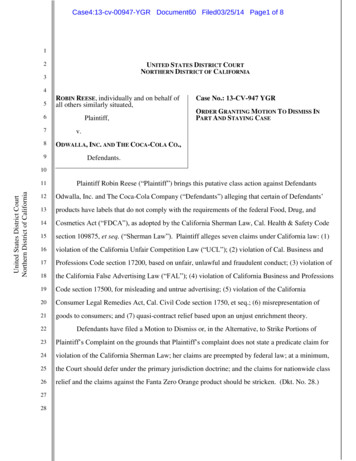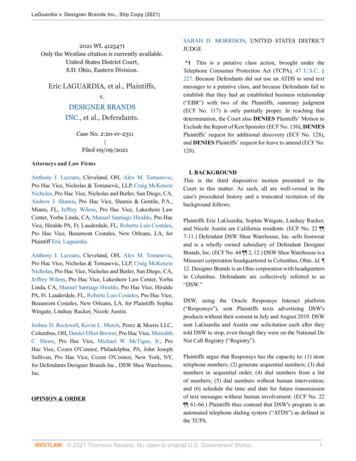
Transcription
LaGuardia v. Designer Brands Inc., Slip Copy (2021)2021 WL 4125471Only the Westlaw citation is currently available.United States District Court,S.D. Ohio, Eastern Division.Eric LAGUARDIA, et al., Plaintiffs,v.DESIGNER BRANDSINC., et al., Defendants.Case No. 2:20-cv-2311 Filed 09/09/2021SARAH D. MORRISON, UNITED STATES DISTRICTJUDGE*1 This is a putative class action, brought under theTelephone Consumer Protection Act (TCPA), 47 U.S.C. §227. Because Defendants did not use an ATDS to send textmessages to a putative class, and because Defendants fail toestablish that they had an established business relationship(“EBR”) with two of the Plaintiffs, summary judgment(ECF No. 117) is only partially proper. In reaching thatdetermination, the Court also DENIES Plaintiffs’ Motion toExclude the Report of Ken Sponsler (ECF No. 130), DENIESPlaintiffs’ request for additional discovery (ECF No. 128),and DENIES Plaintiffs’ request for leave to amend (ECF No.128).Attorneys and Law FirmsAnthony J. Lazzaro, Cleveland, OH, Alex M. Tomasevic,Pro Hac Vice, Nicholas & Tomasevic, LLP, Craig McKenzieNicholas, Pro Hac Vice, Nicholas and Butler, San Diego, CA,Andrew J. Shamis, Pro Hac Vice, Shamis & Gentile, P.A.,Miami, FL, Jeffrey Wilens, Pro Hac Vice, Lakeshore LawCenter, Yorba Linda, CA, Manuel Santiago Hiraldo, Pro HacVice, Hiraldo PA, Ft. Lauderdale, FL, Roberto Luis Costales,Pro Hac Vice, Beaumont Costales, New Orleans, LA, forPlaintiff Eric Laguardia.Anthony J. Lazzaro, Cleveland, OH, Alex M. Tomasevic,Pro Hac Vice, Nicholas & Tomasevic, LLP, Craig McKenzieNicholas, Pro Hac Vice, Nicholas and Butler, San Diego, CA,Jeffrey Wilens, Pro Hac Vice, Lakeshore Law Center, YorbaLinda, CA, Manuel Santiago Hiraldo, Pro Hac Vice, HiraldoPA, Ft. Lauderdale, FL, Roberto Luis Costales, Pro Hac Vice,Beaumont Costales, New Orleans, LA, for Plaintiffs SophiaWingate, Lindsay Rucker, Nicole Austin.Joshua D. Rockwell, Kevin L. Murch, Perez & Morris LLC,Columbus, OH, Daniel Elliot Brewer, Pro Hac Vice, MeredithC. Slawe, Pro Hac Vice, Michael W. McTigue, Jr., ProHac Vice, Cozen O'Connor, Philadelphia, PA, John JosephSullivan, Pro Hac Vice, Cozen O'Connor, New York, NY,for Defendants Designer Brands Inc., DSW Shoe Warehouse,Inc.OPINION & ORDERI. BACKGROUNDThis is the third dispositive motion presented to theCourt in this matter. As such, all are well-versed in thecase's procedural history and a truncated recitation of thebackground follows.Plaintiffs Eric LaGuardia, Sophia Wingate, Lindsay Rucker,and Nicole Austin are California residents. (ECF No. 22 ¶¶7-11.) Defendant DSW Shoe Warehouse, Inc. sells footwearand is a wholly owned subsidiary of Defendant DesignerBrands, Inc. (ECF No. 44 ¶¶ 2, 12.) DSW Shoe Warehouse is aMissouri corporation headquartered in Columbus, Ohio. Id. ¶12. Designer Brands is an Ohio corporation with headquartersin Columbus. Defendants are collectively referred to as“DSW.”DSW, using the Oracle Responsys Interact platform(“Responsys”), sent Plaintiffs texts advertising DSW'sproducts without their consent in July and August 2019. DSWsent LaGuardia and Austin one solicitation each after theytold DSW to stop, even though they were on the National DoNot Call Registry (“Registry”).Plaintiffs argue that Responsys has the capacity to: (1) storetelephone numbers; (2) generate sequential numbers; (3) dialnumbers in sequential order; (4) dial numbers from a listof numbers; (5) dial numbers without human intervention;and (6) schedule the time and date for future transmissionof text messages without human involvement. (ECF No. 22¶¶ 61-66.) Plaintiffs thus contend that DSW's program is anautomated telephone dialing system (“ATDS”) as defined inthe TCPA. 2021 Thomson Reuters. No claim to original U.S. Government Works.1
LaGuardia v. Designer Brands Inc., Slip Copy (2021)Count 1 alleges that DSW violated § 227(b)(1)(A)(iii) of theTCPA by willfully and/or knowingly contacting Plaintiffs ontheir cellular telephones using an ATDS. Id. ¶¶ 82-87. Count2 asserts that DSW violated § 227(c) of the TCPA by sendingthe texts to LaGuardia and Austin despite the fact that theywere on the Registry and by continuing to send the textsafter they told DSW to stop. Id. ¶¶ 88-91. Plaintiffs seekFed. R. Civ. P. 23 certification of two classes and one subclass. Id. ¶¶ 71-72. In addition to class certification, Plaintiffsseek compensatory, statutory punitive, and treble damages;attorney's fees; costs, and an injunction requiring DSW tocease all text “spam” activities. Id. ¶ 6, Prayer for Relief ¶¶1-6. DSW denies all claims. (ECF No. 44.)The Court's October 27, 2020 Opinion & Order (ECF No. 93)denied Defendants’ Motion for Judgment on the Pleadings.The Court's May 24, 2021 Opinion and Order (ECF No. 133)denied Defendants’ subsequent Motion to Dismiss.*2 Magistrate Judge Vascura's Preliminary Pretrial Order(ECF No. 97) (“Preliminary Order”) established January 15,2021 as the deadline for DSW to file a summary judgmentmotion on the “threshold issues” of whether: “(1) . theplatform used to send the at-issue texts is an ATDS ascontemplated under the TCPA and (2) . Plaintiffs had EBRswhen the at-issue texts were sent.” (ECF No. 97, PageID1025-26.) The Preliminary Order further set March 8, 2021as the discovery deadline for those “targeted” issues whilenoting that “the parties must schedule their discovery in sucha way as to require all responses to be served prior to thedeadline and must also file any motions relating to discoverywithin the discovery period.” Id. at 1025. The PreliminaryOrder scheduled April 5, 2021 as the Plaintiffs’ deadlineto oppose DSW's Motion for Summary Judgment. Id. at1026. Lastly, the Preliminary Order stayed class certificationmotions until after the threshold issues were resolved. Id. at1023.DSW sought, and obtained, two extensions of the dispositivemotion deadline. (ECF Nos. 106, 111.) Plaintiffs requested,and received, two extensions of the discovery deadline. (ECFNos. 120, 123.)DSW's timely Motion for Summary Judgment is fully briefed.(ECF No. 117.) Plaintiffs’ Motion to Exclude the Report ofKen Sponsler, DSW's expert, is likewise ripe. (ECF No. 130.)The Court turns to the latter before addressing the former.II. MOTION TO EXCLUDEPlaintiffs seek exclusion of Ken Sponsler's opinions onreliability grounds. Sponsler first opines that Responsys“cannot store or produce numbers to be called using arandom or sequential number generator and does not dialsuch numbers” such that Responsys is not an ATDS. (ECFNo. 117-1, PageID 1190.) Sponsler secondly opines thatResponsys “requires substantial human intervention to sendtext messages.” (ECF No. 117-2, PageID 1190).A. Rule 702“[U]nder Daubert and its progeny, a party proffering experttestimony must show by a ‘preponderance of proof’ thatthe expert whose testimony is being offered is qualified andwill testify to scientific knowledge that will assist the trierof fact in understanding and disposing of relevant issues.”Decker v. GE Healthcare Inc., 770 F.3d 378, 391 (6th Cir.2014) (citations omitted). Federal R. Evid. 702 pertains to theadmissibility of expert testimony and states:A witness who is qualified as an expert by knowledge, skill,experience, training, or education may testify in the formof an opinion or otherwise if:(a) the expert's scientific, technical, or other specializedknowledge will help the trier of fact to understand theevidence or to determine a fact in issue;(b) the testimony is based on sufficient facts or data;(c) the testimony is the product of reliable principles andmethods; and(d) the expert has reliably applied the principles andmethods to the facts of the case.The rule “imposes a special obligation upon a trial judgeto ensure that scientific testimony is not only relevant, butreliable.” Kumho Tire Co. v. Carmichael, 526 U.S. 137, 137(1999) (citing Daubert v. Merrell Dow Pharms., 509 U.S.579 (1993)). This basic gatekeeping obligation applies to allexpert testimony. Kumho Tire Co., 526 U.S. at 147.“The trial court's role as a gatekeeper of expert testimony isnot meant to serve as a replacement of the adversary system.”European Pensions Mgmt. v. Columbus Life Ins. Co., No.1:16-cv-542, 2017 U.S. Dist. LEXIS 167671, at *12 (S.D.Ohio Oct. 11, 2017) (Dlott, J.) (citing Burgett v. Troy-BiltLLC, 579 F. App'x 372, 377 (6th Cir. 2014) (citation omitted)). 2021 Thomson Reuters. No claim to original U.S. Government Works.2
LaGuardia v. Designer Brands Inc., Slip Copy (2021)“[R]ejection of expert testimony is the exception, rather thanthe rule.” In re Scrap Metal Antitrust Litig., 527 F.3d 517,530 (6th Cir. 2008) (citation omitted). Accordingly, “Rule 702should be broadly interpreted on the basis of whether the useof expert testimony will assist the trier of fact.” Morales v.Am. Honda Motor Co., Inc., 151 F.3d 500, 516 (6th Cir. 1998)(citation omitted).B. ATDS*3 Plaintiffs do not dispute Sponsler's knowledge orexperience. Nor do they contest that his ATDS opinion willassist the trier of fact to understand the evidence or determinea fact in issue. Rather, they attack Sponsler's ATDS opinionon reliability grounds. In particular, Plaintiffs argue that hisopinion must be excluded because Sponsler “did not conducta reasonably thorough investigation” such that “his report isunreliable.” (ECF No. 130, PageID 1607.) This equates to aRule 702(b) reliability challenge.Daubert identifies several factors addressing a reliabilitydetermination: testing, peer review, publication, known orpotential rate of error, and general acceptance. Daubert, 509U.S. at 593-94. “The Daubert factors are neither definitivenor exhaustive and may not apply in every case.” EuropeanPensions Mgmt. v. Columbus Life Ins. Co., No. 1:16cv-542, 2017 U.S. Dist. LEXIS 167671, at *12-13 (S.D.Ohio Oct. 11, 2017) (Dlott, J.) (citing Mike's Train House,Inc. v. Lionel, L.L.C., 472 F.3d 398, 407 (6th Cir. 2006)).“Red flags that caution against certifying an expert includereliance on anecdotal evidence, improper extrapolation,failure to consider other possible causes, lack of testing, andsubjectivity.” Newell Rubbermaid, Inc. v. Raymond Corp.,676 F.3d 521, 527 (6th Cir. 2012). Those red flags are thesource of Plaintiffs’ contention that exclusion is warranted.1. Ability to Store Telephone NumbersProng one of Sponsler's ATDS opinion is that Responsyscannot store telephone numbers “to be called using a randomor sequential number generator.” (ECF No. 117-2, PageID1190.) Plaintiffs contend that this opinion is unreliablebecause Sponsler's “report does not detail any document orwitness who would have provided him with the informationnecessary to opine that the Responsys system cannot storephone numbers using a random or sequential numbergenerator.” (ECF No. 130, PageID 1610.)Plaintiffs are mistaken. The report specifies that he: Reviewed pleadings in this Action ., including the Court'sOctober 27, 2020 Opinion and Order; Reviewed manuals that describe the capabilities ofResponsys and are available on Oracle's website; Interviewed DSW's Senior Manager of Digital ApplicationsDevelopment, Rich Clum, regarding DSW's use of andinterface with Responsys; Arranged and attended via videoconference a demonstrationof the capabilities and customer interface of Responsys,conducted by Mr. Clum and Heather Hutchison, a DSWAnalyst who has worked with Responsys; Observed the functionality available to DSW on theResponsys interface during the demonstration; Conducted a question and answer session during thedemonstration on the capabilities of and DSW's interface withResponsys; Reviewed the declaration of DSW's Director of DataEngineering & Analytics, Michael Shebetich, regardingResponsys's capabilities and DSW's interaction withResponsys; Reviewed the deposition testimony of SurechKalyanaraman, Senior Director at Oracle, from TCPAlitigation—Eldridge v. Pet Supermarket, Inc., No. 1:18cv22531-KMW (Dkt. No. 77-3) (S.D. Fla.) . regardingResponsys's capabilities, including whether it can generaterandom or sequential phone numbers; Considered, among other parts of his testimony, Mr.Kalyanaraman's testimony that he (i) influences thefeatures that Oracle software developers implement inResponsys's source code and (ii) is responsible forproduction management for Responsys, meaning that heidentifies the features and capabilities that Oracle wantsits software developers to implement in Responsys andthen communicates them to the software developers via arequirements document; and 2021 Thomson Reuters. No claim to original U.S. Government Works.3
LaGuardia v. Designer Brands Inc., Slip Copy (2021)*4 Reviewed Mr. Kalyanaraman's testimony aboutResponsys’ capability to generate random or sequential phonenumbers and inability to be programmed to do so:Q: The -- the ability of the Respons[y]s system toproduce telephone numbers through -- to generate on itsown, telephone numbers without having that informationuploaded into its software?A: There is no such capability.Q: Okay.A: Yeah. So question number 15 is not applicable. Onceagain, question number 16 is also not applicable becauseRespons[y]s does not have a piece of software to generatenumbers in a sequential fashion.***Q: [ ] Is the Respons[y]s platform capable of randomlygenerating a telephone number and dialing that number?A: No.Q: Is it -- is the Respons[y]s platform capable of generatinga sequential number and dialing that number?A: No.***Q: [ ] Could the Respons[y]s system be programmed togenerate random or sequential numbers and dial thosenumbers?A:No.(ECF No. 132, PageID 1680-1682) (internal citationsomitted).The Court determines that Sponsler's review of thosematerials, which are of the type that are reasonably reliedupon by experts in the field of global-direct marketingcompliance, combined with his twenty-one years’ ofexperience in that field, provide a sufficient foundation forhis determination that Responsys cannot store telephonenumbers “to be called using a random or sequential numbergenerator.” (ECF No. 117-2, PageID 1190.) Plaintiffs’Motion to Exclude this opinion is DENIED. (ECF No. 130.)2. Ability to Produce Telephone NumbersPlaintiffs seek exclusion of Sponsler's linked conclusionthat Responsys is incapable of producing numbers to becalled because he “failed to thoroughly investigate thetrue capabilities of the Responsys system.” (ECF No.134, PageID 1736.) According to Plaintiffs, that failureconsisted of: (1) inspecting only the functionalities used bythe Defendant and not all potential functionalities of theequipment; (2) considering Kalyanaraman's testimony eventhough Sponsler did not know Kalyanaraman; and (3) failingto ask about Responsys’ functionalities that conflicted withhis conclusion. (ECF No. 134, PageID 1739.) Plaintiffs arguethese omissions “mean that his opinion ultimately cannotbe tested—because it is based on incomplete data—and, forthe same reason, his opinion is no more than an unfoundedextrapolation.” (ECF No. 134, PageID 1736.)By highlighting what Sponsler did not do instead of what hedid do, Plaintiffs attack his credibility and the weight thatshould be given to his opinion. But credibility and weightare jury issues. Further, Plaintiffs do not challenge Sponsler'sknowledge or experience. The foundation for his productionopinion is the same as for his storage opinion. The Court findsthat foundation sufficient above. So the Motion to Exclude(ECF No. 130) Sponsler's opinion as to Responsys’ inability“to produce numbers to be called using a random or sequentialnumber generator” is DENIED. (ECF No. 117-2, PageID1190.)3. Ability to Dial Telephone NumbersProng three of Sponsler's first opinion is that Responsys doesnot “dial” random or sequential numbers. While Plaintiffs’Motion (ECF No. 130) does not seek exclusion of thisopinion, Plaintiffs’ Reply (ECF No. 134) does.*5 “[A] reply brief is not the proper place to raise an issuefor the first time.” United Tel. Co. of Ohio v. Ameritech Servs.,Inc., No. 2:10-cv249, 2011 U.S. Dist. LEXIS 1746, 2011WL 53462, at *3 n. 2 (S.D. Ohio Jan. 7, 2011) (Frost, J.).Consequently, the “Court need not and will not consider”Plaintiffs’ “new or newly recast arguments.” Ross v. ChoiceHotels Int'l, Inc., 882 F. Supp. 2d 951, 958 (S.D. Ohio2012) (Frost, J.). Plaintiffs’ Motion to Exclude this aspect ofSponsler's report is DENIED. (ECF No. 130.) 2021 Thomson Reuters. No claim to original U.S. Government Works.4
LaGuardia v. Designer Brands Inc., Slip Copy (2021)C. Human InterventionA key issue in this case is whether Responsys qualifies asan ATDS under the TCPA. At the time Sponsler released hisreport, courts examined the amount of human action that wasnecessary for a dialing platform to operate when consideringwhether it qualified as an ATDS under the Act. See Garyv. TrueBlue, Inc., No. 17-CV-10544, 2018 WL 3647046, at*7 (E.D. Mich. Aug. 1, 2018); see also Gary v. TrueBlue,Inc., 346 F. Supp. 3d 1040, 1045–46 (E.D. Mich. 2018), aff'd,786 F. App'x 555 (6th Cir. 2019); see also Ramos v. Hopeleof Fort Lauderdale, LLC, 334 F. Supp. 3d 1262, 1273 (S.D.Fla. 2018). As such, Sponsler opines that Responsys “requiressubstantial human intervention to send text messages” suchthat it is not an ATDS under the TCPA. (ECF No. 117-2,PageID 1190.)The Supreme Court decided Facebook, Inc. v. Duguid, 141S. Ct. 1163 (2021), after Sponsler's report. Duguid addressedthe issue of whether the ATDS “definition encompassesequipment that can ‘store’ and dial telephone numbers, evenif the device does not ‘us[e] a random or sequential numbergenerator.’ ” Duguid, 141 S. Ct. at 1167. The answer? “It doesnot. To qualify as an ‘automatic telephone dialing system,’a device must have the capacity either to store a telephonenumber using a random or sequential generator or to producea telephone number using a random or sequential numbergenerator.” Id. In reaching that determination, the SupremeCourt commented:all devices require some human intervention, whether ittakes the form of programming a cell phone to respondautomatically to texts received while in ‘do not disturb’mode or commanding a computer program to produce anddial phone numbers at random. We decline to interpret theTCPA as requiring such a difficult line-drawing exercisearound how much automation is too much.Id. at 1175.From this, Plaintiffs argue that Sponsler's human interventionopinion must be excluded under Fed. R. Evid. 702(a)as irrelevant because Duguid makes clear that humaninvolvement is no longer a litmus test for ATDS status.(ECF No. 130, PageID 1608-1609.) DSW partially concedesthis point, noting that while Sponsler's opinion “has perhapstaken on less importance since Duguid,” “the level ofhuman intervention required to input phone numbers intoResponsys's system illustrates that . Responsys can neitherproduce nor store telephone numbers using a randomor sequential number generator, further supporting theconclusion that Responsys is not an ATDS.” (ECF No. 132,PageID 1690-1691.) In other words, the human interventionportion of the report serves only to buttress Sponsler's opinionthat Responsys is not an ATDS.The Court concurs with DSW that in light of Duguid,Sponsler's human intervention conclusion serves asexplanatory evidence, not as a freestanding opinion. Putdifferently, the human intervention discussion would help thetrier of fact understand why Responsys cannot independentlyproduce or store telephone numbers using a random orsequential number generator. See Rule 702(a). Exclusion istherefore improper.*6 In sum, Plaintiffs’ Motion to Exclude is DENIED. (ECFNo. 130.)III. REQUEST FOR ADDITIONAL DISCOVERYContained within Plaintiffs’ Summary Judgment Oppositionis a Fed. R. Civ. P. 56(d) request to “subpoena and deposeOracle on the topic of” Responsys and whether Responsys“can ‘store’ telephone numbers using a random or sequentialnumber generator.” (ECF No. 128, PageID 1462; ECFNo. 128-1 ¶¶ 4-5.) Plaintiffs assert this discovery becamenecessary after Duguid was decided on April 1, 2021. (ECFNo. 128, PageID 1462; ECF No. 128-1.)Plaintiffs did not raise their plea in a separate motion,thereby precluding the Court's review. See S.D. Ohio Civ.R. 7.2(a)(1); see also Arnett v. Pontiac Police Dep't, No.97-1142, 1999 U.S. App. LEXIS 30219, at *2 (6th Cir. Aug.9, 1999) (holding “district court did not err by failing torule specifically on Arnett's request for the appointment ofcounsel, which was included as a component of his requestfor relief in his complaint but was not made by separatemotion.”). Even if the Court were to consider Plaintiffs’ ask,even before Duguid was announced, the functionality of theResponsys platform was at issue in this case. Plaintiffs hadample opportunity to obtain the information they now claimthey need. Their post-deadline request for relief is untimely.For these reasons, Plaintiffs’ Rule 56(d) request is DENIED.IV. MOTION FOR SUMMARY JUDGMENTBecause DSW conclusively establishes that Responsys is notan ATDS but fails to adequately prove that the EBR exceptionapplies to LaGuardia's and Austin's Registry claims, DSW is 2021 Thomson Reuters. No claim to original U.S. Government Works.5
LaGuardia v. Designer Brands Inc., Slip Copy (2021)entitled to judgment as a matter of law on Count 1 but not onCount 2.A. Standard of ReviewUnder Federal Rule of Civil Procedure 56, summaryjudgment is proper if the evidentiary materials in the recordshow that there is “no genuine dispute as to any material factand the movant is entitled to judgment as a matter of law.”Fed. R. Civ. P. 56(a); see Longaberger Co. v. Kolt, 586 F.3d459, 465 (6th Cir. 2009). The moving party bears the burdenof proving the absence of genuine issues of material fact andits entitlement to judgment as a matter of law, which maybe accomplished by demonstrating that the nonmoving partylacks evidence to support an essential element of its case onwhich it would bear the burden of proof at trial. See CelotexCorp. v. Catrett, 477 U.S. 317, 322-23 (1986); Walton v. FordMotor Co., 424 F.3d 481, 485 (6th Cir. 2005).The “mere existence of some alleged factual dispute betweenthe parties will not defeat an otherwise properly supportedmotion for summary judgment; the requirement is that therebe no genuine issue of material fact.” Anderson v. LibertyLobby, Inc., 477 U.S. 242, 247-48 (1986) (emphasis inoriginal); see also Longaberger, 586 F.3d at 465. “Onlydisputed material facts, those ‘that might affect the outcomeof the suit under the governing law,’ will preclude summaryjudgment.” Daugherty v. Sajar Plastics, Inc., 544 F.3d 696,702 (6th Cir. 2008) (quoting Anderson, 477 U.S. at 248).Accordingly, the nonmoving party must present “significantprobative evidence” to demonstrate that “there is [more than]some metaphysical doubt as to the material facts.” Moore v.Philip Morris Cos., Inc., 8 F.3d 335, 340 (6th Cir. 1993).*7 A district court considering a motion for summaryjudgment may not weigh evidence or make credibilitydeterminations. Daugherty, 544 F.3d at 702; Adams v. Metiva,31 F.3d 375, 379 (6th Cir. 1994). Rather, in reviewinga motion for summary judgment, a court must determinewhether “the evidence presents a sufficient disagreement torequire submission to a jury or whether it is so one-sided thatone party must prevail as a matter of law.” Anderson, 477U.S. at 251-52. The evidence, all facts, and any inferences thatmay permissibly be drawn from the facts must be viewed inthe light most favorable to the nonmoving party. MatsushitaElec. Indus. Co. v. Zenith Radio Corp., 475 U.S. 574, 587(1986); Eastman Kodak Co. v. Image Technical Servs., Inc.,504 U.S. 451, 456 (1992). However, “[t]he mere existenceof a scintilla of evidence in support of the plaintiff's positionwill be insufficient; there must be evidence on which the jurycould reasonably find for the plaintiff.” Anderson, 477 U.S. at252; see Dominguez v. Corr. Med. Servs., 555 F.3d 543, 549(6th Cir. 2009).B. Count 1 - ATDSCount 1 alleges that DSW violated § 227(b)(1)(A)(iii) of theTCPA by willfully and/or knowingly contacting Plaintiffs ontheir cellular telephones using an ATDS. (ECF No. 22 ¶¶82-87.) DSW responds that Responsys lacks certain requiredcapabilities preventing the platform from qualifying as anATDS under the Act.As noted, “[t]o qualify as an ‘automatic telephone dialingsystem,’ a device must have the capacity either to store atelephone number using a random or sequential generator orto produce a telephone number using a random or sequentialnumber generator.” Duguid, 141 S. Ct. at 1167. Sponsler'sunrebutted expert opinion establishes that Responsys hasneither. (ECF No. 117-2, PageID 1190.)Faced with this unrefuted evidence, Plaintiffs note Responsysissues a sequential identification number (“ID number”)for every message it sends. (ECF No. 128, PageID 1460.)Responsys then uses the ID number to track responses. Id.Plaintiffs assert “[t]here is no clearer example of ‘storing’ atelephone number ‘to be called’ using a ‘sequential numbergenerator’ than the Responsys [sic] system of generatingsequential ID numbers for each text message communicationit sends and then using those ID numbers to categorizewhether to call those particular phone numbers in thefuture—or alternatively opt them out of a campaign.” Id.Consequently, Plaintiffs argue Responsys’ ability to randomlygenerate message ID numbers qualifies it as an ATDS.Plaintiffs’ focus is off. The ATDS definition addresses theability to randomly or sequentially store or generate phonenumbers, not message identification numbers. See Tehraniv. Joie De Vivre Hosp., LLC, No. 19-cv-08168-EMC, 2021U.S. Dist. LEXIS 165392, at *10 (N.D. Cal. Aug. 31,2021) (holding “number generator” in § 227(a)(1) refers totelephone numbers).Plaintiffs’ reference to Duguid’s footnote seven in furthersupport of their ID number argument fares no better. Footnoteseven provides: 2021 Thomson Reuters. No claim to original U.S. Government Works.6
LaGuardia v. Designer Brands Inc., Slip Copy (2021)Duguid argues that such a device would necessarily“produce” numbers using the same generator technology,meaning “store or” in § 227(a)(1)(A) is superfluous. “Itis no superfluity,” however, for Congress to include bothfunctions in the autodialer definition so as to clarify thedomain of prohibited devices. For instance, an autodialermight use a random number generator to determine theorder in which to pick phone numbers from a preproducedlist. It would then store those numbers to be dialed at a latertime. See Brief for Professional Association for CustomerEngagement et al. as Amici Curiae 19. In any event, even ifthe storing and producing functions often merge, Congressmay have “employed a belt and suspenders approach” inwriting the statute.*8 Duguid, 141 S. Ct. at 1172 n.7 (some citations omitted;emphasis added). In essence, Plaintiffs contend that this dicta,which addresses a hypothetical in an amicus brief, establishesthat Responsys is an ATDS because of its ability to randomlygenerate ID numbers and to use those numbers to determinewhich phone numbers to send text messages to. (ECF No.128, PageID 1460.) A “clear majority of courts” discount suchreliance. Tehrani aptly summarizes their holdings as follows: Hufnus v. Donotpay, Inc., No. 20-cv-08701-VC, 2021U.S. Dist. LEXIS 118325, at *3-4 (N.D. Cal. June 24,2021) (finding that plaintiff's “reading of footnote 7conflicts with Duguid's holding and rationale[;] [t]heSupreme Court explained in Duguid that the TCPA'sdefinition of autodialer concerns devices that allowcompanies ‘to dial random or sequential blocks oftelephone numbers automatically,’ not systems, such asDoNot Pay's, that randomly or sequentially dial numbersfrom a list that was itself created in a non-random, nonsequential way”). Watts v. Emergency Twenty Four, Inc., No. 20-cv-1820,2021 U.S. Dist. LEXIS 115053, at *8-9 (N.D. Ill. June21, 2021) (concluding that plaintiff had not alleged theuse of an autodialer; “the alleged facts suggest thatinstead of randomly or sequentially generating Watts'snumber, EMERgency24's equipment stored Watts'snumber in a database and dialed that stored numberbecause he was an employee at a business that usedEMERgency24's alarm notification system”). Barry v. Ally Fin., Inc., No. 20-12378, 2021 U.S. Dist.LEXIS 129573, at *17-19 (E.D. Mich. July 13, 2021)(stating that “Plaintiff takes footnote 7 out of context”;“the ‘preproduced list’ of phone numbers referencedin the footnote was itself created through a random orsequential number generator”). Borden v. efinancial, LLC, No. C19-1430JLR, 2021 U.S.Dist. LEXIS 153086, at *14-16 (W.D. Wash. Aug. 13,2021) (stating that “Mr. Borden's argument relies ona selective reading of one line within footnote 7 andignores the greater context of that footnote and theopinion”). Timms v. USAA Fed. Sav. Bank, No. 3:18-cv-01495SAL, 2021 U.S. Dist. LEXIS 108083, at *17 (D.S.C.June 9, 2021) (holding that “footnote 7 does not supportPlaintiff's argument”; “the Supreme Court's statement —that an ‘autodialer might use a random number generatorto determine the order in which to pick phone numbersfrom a preproduced list’ and ‘then store those numbersto be dialed at a later time’ - refers to the process asexplained by PACE on page 19 of its amicus brief”).Tehrani, 2021 U.S. Dist. LEXIS 165392, at *18-20.This Court adopts their reasoning. DSW's Motion forSummary Judgment on Count 1 is GRANTED. (ECF No.117.)C. Count 2 – Do Not Call RegistrySection 227(c) of the TCPA and corresponding 47 C.F.R.64.1200(c)(2) prohibit telephone solicitations to residentialtelephone subscribers who are listed in the national Registry.Count 2 asserts that DSW violated both by sending the textsto LaGuardia and Austin despite the fact that they were on theRegistry and by continuing to send the texts to them after theytold DSW to stop. (ECF No. 22 ¶¶ 88-91.) DSW argues thatthe texts were permissible because LaGuardia and Austin hadan “EBR” with DSW and because their “stop” requests werelegally insufficient. (ECF No.
DSW, using the Oracle Responsys Interact platform ("Responsys"), sent Plaintiffs texts advertising DSW's products without their consent in July and August 2019. DSW sent LaGuardia and Austin one solicitation each after they told DSW to stop, even though they were on the National Do Not Call Registry ("Registry"). Plaintiffs argue that .
